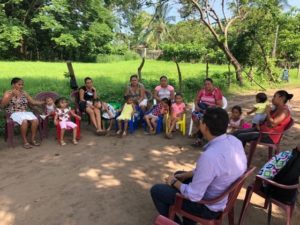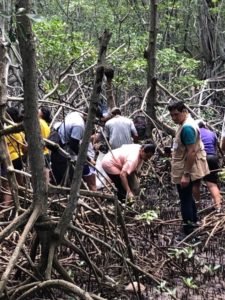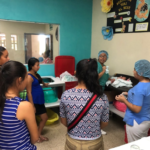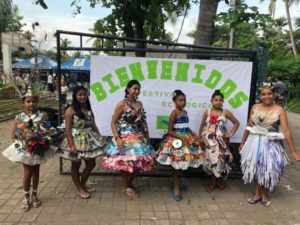After returning home one week ago from El Zapote I finally find time to write about my time in the beautiful village…But let me begin from the start.
Week 1: First impressions, presenting my mental health project and the first emergency
My first impressions of El Salvador were breathtaking thanks to our dear friend Edgar, who gave me a ride in his car from the airport via the panoramic highway along the coast. Deep blue water lined by palm trees and green cliffs. After being welcomed warmly by my neighbours Señora Sonia and Paulina, the doctor Alejandro showed me around the Health Station. Even though it was Sunday we spend the afternoon constructing a raft for the upcoming “Environmental Day” organized by the school. The next morning I got to know the rest of the team: Señora Ventura, Zuleyma, Lorena, Ever and Don Fermin and spent the first day helping the doctor in the consultation. The health station does basically everything: evaluating newborns, doing check-ups during pregnancy, speculum examinations, little surgical procedures like sewing or curing wounds and of course the most frequent diseases: diarrhea because of contaminated water and respiratory diseases.


On Tuesday we went to Porvenir, which is the village next to El Zapote, in order to hold a talk about diarrhea. Cases especially among children were rising the last weeks and therefore we emphasized how to prevent and treat diarrhea.

On Wednesday I had the special opportunity to participate at the “Environmental Day” of the school. The pupils organized many different activities: First around 200 people (pupils, parents and invited guests) spread out to plant different kind of trees in the community: Of course we also planted two trees in the Unidad de Salud and the nutrition center. After that we went out in boots to learn more about the “bosque salado”, one of the biggest mangrove forests in Central America. In the afternoon Alejandro participated (more or less successful) in the raft race against the pupils. All of the rafts were fully made out of recycled plastic bottles in order to raise awareness. The same purpose had the last activity of the day: Choosing the Queen of Recycling. Girls from every grade produced incredibly elaborated dresses made out of all kinds of materials: crown caps, lids, plastic spoons etc.



On the next day I presented my mental health project to the pupils of the last year: The idea was to perform a survey with them, containing demographical questions and the PHQ-9 depression tool in order to know the prevalence of depression among children between 15-20 years and to figure out possible risk factors. The kids seemed to be willing to participateJ
The first week ended on Sunday with a severe emergency in the neighborhood: We were called to a 2-year old girl with ongoing fever convulsions for already 10 minutes. As the Health Stations doesn’t count with any anticonvulsants, we drove with her immediately to the bigger Health Station in Cara Sucia. In that moment the 40 minutes drive on the bumpy road seemed like ages, especially because the girl developed a second convulsion and the only thing we could do were keeping an eye on the vital parameters. From there she was directly transported to the next hospital in the bigger town Sonsonate (another 40minutes drive!). The little girl was discharged home the same night and luckily, didn’t have any symptoms the next day at the Health Station. But this incidence demonstrated how badly some medicine is missing, especially because the nearest hospital is so far away.
Week 2-3: Daily routine at the Health Station and Development of the depression survey
During the two weeks I helped every day in the Health Station during the mornings and worked on the Depression Survey on the afternoon.
One highlight was doing fieldwork: Because the government aimed to vaccine 100 % of the children against influenza, we drove with the motorbike from house to house and convinced the parents about the importance of the vaccine. In almost all cases we could vaccine right away, only 3 children were left without vaccines because of the refusal of their parents.


Doing fieldwork with Zuleyma Aiming of give influenza vaccines to 100 % of the kids
On two days Alejandro had important appointments with other health stations, so we officially closed the Health Station. But of course we had a look on urgent cases in order to at least send them to the next Health Station at Garita Palmera or Cara Sucia. I felt a big feeling of responsibility to have to rely completely on my own clinical examination for the first time before discussing the case with Alejandro.
On one Friday we had another emergency: A woman who gave birth five days ago came to the Health Station. The birth was complicated and was finally only managed with a cesarean section and a hemolytic shock of the mother. She visited the doctor, because her cesarean wound was smelling bad since 2 days. In the clinical examination we found a massively infected wound and vital parameters which fulfilled the shock criteria: She had a septic shock and we wanted to bring her to the hospital in Sonsonate as soon as possible with her blood pressure of only 80/45 mmHg. After starting a NaCl-Infusion we took her in Alejandros car to the ambulance in Cara Sucia. Unfortunately the battery broke down after 10min and we had to organize another car. After another infusion and 2,5h later we finally arrived with her in the hospital in Sonsonate. Luckily she could be treated soon and was released after a couple of days. But nevertheless this experience showed me again how vital good healthcare in the village and also a good infrastructure is. Getting to the nearest hospital in 2,5h can be too long in many cases.
Alejandro and Señora Ventura had to go to an appointment in Santa Ana for a day, so the Health Station was closed and they took me with them in order to get to know a little bit of the country. We were so lucky to see the Lake Coatepeque in his changed colour of bright blue. Nobody knows the reason for it, but it happens every year in summer for about 10 days and then turns back into a dark blue again. We had an awesome team excursion, had great pupusas and did something for our mental health.

Team excursion to Lake Coatepeque near to Santa Ana
For the depression survey I worked out all of the risk factors and demographical questions I wanted to ask and did all the organization in agreement with the school for carrying the survey out in the last week.
Week 4: Depression Survey and Goodbyes
The last week in El Zapote started with cooking Pupusas for breakfast for the whole team and the kids of the nutrition center. It was great fun and “the girls” Senora Ventura, Zuleyma and Lorena tried to teach me the right technic of preparing them. Mine weren’t looking nearly as good as theirs, but all of them tasted delicious.

Lorena being the frying chef of the pupusas


Trying to learn the best technic for preparing pupusas from the professionals: Señora Ventura y Zuleyma
On Tuesday and Wednesday I handed out the printed Depression Survey to the two last school years: Primero y Segundo. I collected them the next days and from in total 25 kids in both classes 20 children returned the survey completely filled out.
| Total Score | Depression Severity |
| 0-4 | None |
| 5-9 | Mild |
| 10-14 | Moderate |
| 15-19 | Moderately Severe |
| 20-27 | Severe |
Interpretation of Total Score in the PHQ-9 questionnaire
There were in total 9 children (45 %) which were in the range of 0-4 score points and therefore didn’t show any signs of depression. 7 children (35 %) belonged to the group of a mild depression severity with 5-9 score points. Two of the kids (10 %) had moderate depression signs in the score range of 10-14 points and one girl (5 %) had a severe depression severity with 21 score points. So in total half of the children (50 %) showed depression signs.
| Total Score | Depression Severity | Number of children |
| 0-4 | None | 9 |
| 5-9 | Mild | 7 |
| 10-14 | Moderate | 2 |
| 15-19 | Moderately Severe | 0 |
| 20-27 | Severe | 1 |
Number of children (20 in total) with scores in the different depression severity groups.

Number of children in the different groups of Depression Severity.
The results have to be treated with caution because there are only from one anonymous survey and without making a psychopathological anamnesis with the kids. And the number of surveyed children is with only 20 too small to draw general conclusions.
Nevertheless I was surprised by the number of children with signs of depression. In the literature the rate of depression among 12-17 year old adolescence is described with 3-10 %. The number of children in our survey with a moderate or severe depression severity is 15 %.
These results emphasize the necessity of a sensitization of the population about mental health issues, and especially about the disease depression. Apart from offering the children the help of Alejandro, as a doctor, we plan to go to the school and educate the children about mental health topics with a focus on depression. Furthermore my two colleagues, who will stay in El Zapote from middle of august on, plan to do a psychoeducation and different sport activities with them. They will also start using our depression questionnaire with patients of the Health Station.
On my last day in El Zapote I accompanied Señora Ventura with 10 pregnant women to Cara Sucia and Sonsonate. We visited the Delivery Room and the maternity ward in order to take their fears away, inform them about the whole procedure and convince them to go to the hospital for giving birth instead of staying home.


Getting to know the pregnancy center in Cara Sucia + hospital in Sonsonate with 10 pregnant women.
I am so grateful for my time in El Zapote! I learned so much more than I could ever learn in one month in Germany and found new friends who will stay in my heart forever. Thank you so much, Unified for Health, for making this unique experience possible. I’m sure it won’t be the last time in El Salvador and El Zapote.
